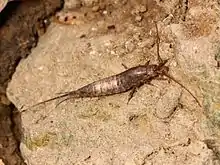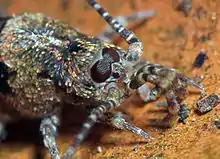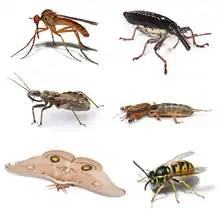Archaeognatha
The Archaeognatha are an order of apterygotes, known by various common names such as jumping bristletails. Among extant insect taxa they are some of the most evolutionarily primitive; they appeared in the Middle Devonian period at about the same time as the arachnids. Specimens that closely resemble extant species have been found as both body and trace fossils (the latter including body imprints and trackways) in strata from the remainder of the Paleozoic Era and more recent periods.[3] For historical reasons an alternative name for the order is Microcoryphia.[4]
| Archaeognatha Temporal range: | |
|---|---|
 | |
| Rock bristletail | |
| Scientific classification | |
| Domain: | Eukaryota |
| Kingdom: | Animalia |
| Phylum: | Arthropoda |
| Class: | Insecta |
| Subclass: | Monocondylia Haeckel, 1866 |
| Order: | Archaeognatha Börner, 1904 |
| Families[2] | |
| |
| Synonyms | |
| |
Until the late 20th century the suborders Zygentoma and Archaeognatha comprised the order Thysanura; both orders possess three-pronged tails comprising two lateral cerci and a medial epiproct or appendix dorsalis. Of the three organs, the appendix dorsalis is considerably longer than the two cerci; in this the Archaeognatha differ from the Zygentoma, in which the three organs are subequal in length.[4] In the late 20th century, it was recognized that the order Thysanura was paraphyletic, thus the two suborders were each raised to the status of an independent monophyletic order, with Archaeognatha sister taxon to the Dicondylia, including the Zygentoma.[5]
The order Archaeognatha is cosmopolitan; it includes roughly 500 species in two families.[6] No species is currently evaluated as being at conservation risk.[7]
Description
Archaeognatha are small insects with elongated bodies and backs that are arched, especially over the thorax. Their abdomen ends in three long tail-like structures, of which the lateral two are cerci, while the medial filament, which is longest, is an epiproct. The tenth abdominal segment is reduced.[8] The antennae are flexible. The two large compound eyes meet at the top of the head, and there are three ocelli. The mouthparts are partly retractable, with simple chewing mandibles and seven-segmented maxillary palps which are commonly longer than the legs.[9][1]: 341–343
Unlike other insect orders, they do not have olfactory receptor-coreceptors (Orco), which have either been lost or were never present in the first place.[10][11]
Archaeognatha differ from Zygentoma in various ways, such as their relatively small head, their bodies being compressed laterally (from side to side) instead of flattened dorsiventrally, and in their being able to use their tails to spring up to 30 cm (12 in) into the air if disturbed. They have eight pairs of short appendages called styli on abdominal segments 2 to 9. Family Machilidae is also unique among insects in possessing small muscleless styli on the second and third thoracic legs,[12] but are absent on the second pair of thoracic legs in some genera.[13] Similar stylets on the legs are absent in family Meinertellidae.[14] They have one or two pairs of eversible membranous vesicles on the underside of abdominal segments 1 to 7, which are used to absorb water and assisting with molting.[15] There are nine pairs of spiracles; two pairs on the thorax, and seven pairs on abdominal segments 2 to 8.[16] The pair of spiracles on the first abdominal segment has been lost.[17]
.jpg.webp)


Further unusual features are that the abdominal sternites are each composed of three sclerites, and they cement themselves to the substrate before molting, often using their own feces as glue.[18] The body is covered with readily detached scales, that make the animals difficult to grip and also may protect the exoskeleton from abrasion. The thin exoskeleton offers little protection against dehydration, and they accordingly must remain in moist air, such as in cool, damp situations under stones or bark.
Etymology
The name Archaeognatha is derived from the Greek ἀρχαῖος, archaios, meaning 'ancient', and γνάθος, gnathos, meaning 'jaw'. This refers to the articulation of the mandibles, which are different from those of other insects. It was originally believed that Archaeognatha possessed a single phylogenetically primitive condyle each (thus the name "Monocondylia"), where all more derived insects have two, but this has since been shown to be incorrect; all insects, including Archaeognatha, have dicondylic mandibles, but archaeognaths possess two articulations that are homologous to those in other insects, though slightly different.[19]
An alternative name, Microcoryphia,[4] comes from the Greek μικρός, mikros, 'small', and κορυφή, koryphē, which in context means 'head'.[20]
Taxonomy
| Families | No. of Species | Defining Notes | Image |
|---|---|---|---|
| Machilidae | 250 | Most are restricted to rocky shorelines | Need specific image |
| Meinertellidae | 170[21] | Lack scales at base of hind legs and antennae | Need specific image |
Biology
Archaeognatha occur in a wide range of habitats. While most species live in moist soil, others have adapted to chaparral, and even sandy deserts. They feed primarily on algae, but also lichens, mosses, or decaying organic detritus.
Three types of mating behavior are known. In some species the male spins a silk thread (carrier thread) stretched out on the ground. On the thread there are droplets of sperm which the female will take up when her ovipositor makes contact. In others a packet of sperm (spermatophore) is deposited on the top of a short stalk. If a female takes up the sperm or not is often random, but in many species the male will try to lead the female's genitals over the sperm during courtship. A more direct way of fertilization occurs in species of the genus Petrobius, where the male place a droplet of sperm directly on the female's ovipositor. [22][23] One hypothesis is that the external genitals of insects started as structures specialized for water-uptake, which could reach deeper crevices than the coxal vesicles, and over time the female would use it to take up sperm from the ground instead of water.[24] After fertilization she lays a batch of around 30 eggs in a suitable crevice. The young resemble the adults, and take up to two years to reach sexual maturity, depending on the species and conditions such as temperature and available food.
Unlike most insects, the adults continue to moult after reaching adulthood, and typically mate once at each instar. Archaeognaths may have a total lifespan of up to four years, longer than most larger insects.[1]
References
- Howell V. Daly; John T. Doyen & Alexander H. Purcell (1998). Introduction to Insect Biology and Diversity (2nd ed.). Oxford University Press. ISBN 0-19-510033-6.
- "Order Archaeognatha Börner 1904". The Paleobiology Database. Retrieved 26 November 2020.
- Patrick R. Getty; Robert Sproule; David L. Wagner & Andrew M. Bush (2013). "Variation in wingless insect trace fossils: insights from neoichnology and the Pennsylvanian of Massachusetts". PALAIOS. 28 (4): 243–258. Bibcode:2013Palai..28..243G. doi:10.2110/palo.2012.p12-108r. S2CID 86430759.
- Timothy J. Gibb (27 October 2014). Contemporary Insect Diagnostics: The Art and Science of Practical Entomology. Academic Press. pp. 78–. ISBN 978-0-12-404692-4.
- A. Blanke, M. Koch, B. Wipfler, F. Wilde, B. Misof (2014) Head morphology of Tricholepidion gertschi indicates monophyletic Zygentoma. Frontiers in Zoology 11:16 doi:10.1186/1742-9994-11-16
- Barnard, Peter C. (19 September 2011). The Royal Entomological Society Book of British Insects. John Wiley & Sons. ISBN 9781444344967.
- NC State University, ENT 425 | General Entomology | Resource Library | Compendium [Archeognatha]
- Gillot, Cedric (14 March 2013). Entomology. Springer. ISBN 9781461569183.
- Resh, Vincent H.; Cardé, Ring T. (22 July 2009). Encyclopedia of Insects. Academic Press. ISBN 9780080920900.
- Wicher, D.; Miazzi, F. (2021). "Functional properties of insect olfactory receptors: Ionotropic receptors and odorant receptors". Cell and Tissue Research. 383 (1): 7–19. doi:10.1007/s00441-020-03363-x. PMC 7873100. PMID 33502604.
- Brand, Philipp; Robertson, Hugh M.; Lin, Wei; Pothula, Ratnasri; Klingeman, William E.; Jurat-Fuentes, Juan Luis; Johnson, Brian R. (2018). "The origin of the odorant receptor gene family in insects". eLife. 7. doi:10.7554/eLife.38340. PMC 6080948. PMID 30063003.
- Snodgrass, R. E. (31 May 2018). Principles of Insect Morphology. Cornell University Press. ISBN 9781501717918.
- Mendes, Luís F. (1990). "An Annotated List of Generic and Specific Names of Machilidae (Microcoryphia, Insecta) with Identification Keys for the Genera and Geographical Notes".
- Sturm, Helmut (1997). "A New Subgenus and Two New Species of the Genus Machilinus (Meinertellidae, Archaeognatha = Microcoryphia, "Apterygota", Insecta) from Mexico". Journal of the New York Entomological Society. 105 (1/2): 15–23. JSTOR 25010224.
- McGavin, George C.; Davranoglou, Leonidas-Romanos (4 January 2023). Essential Entomology. Oxford University Press. ISBN 978-0-19-265483-0.
- Davies, R. G. (11 November 2013). Outlines of Entomology. Springer. ISBN 9789401705080.
- Proceedings of the 1st Dresden Meeting on Insect Phylogeny: "Phylogenetic Relationships within the Insect Orders". (Dresden, September 19-21, 2003)
- Abbott, John C.; Abbott, Kendra (13 October 2020). Common Insects of Texas and Surrounding States. University of Texas Press. ISBN 9781477310359.
- Blanke, Alexander; Machida, Ryuichiro; Szucsich, Nikolaus Urban; Wilde, Fabian; Misof, Bernhard (2015). "Mandibles with two joints evolved much earlier in the history of insects: Dicondyly is a synapomorphy of bristletails, silverfish and winged insects". Systematic Entomology. 40 (2): 357–364. doi:10.1111/syen.12107. S2CID 85309726.
- H. G. Liddell (1889). An Intermediate Greek-English Lexicon: Based on the 7th Ed of Liddell & Scott's Lexicon.
- Song, Zhi-Shun; Huang, Fu-Sheng; Liang, Ai-Ping (2011). "Machilontus (s. str.) medogensis Song & Huang, sp. nov. from Tibet, the northernmost record of the genus Machilontis Silvestri, 1912 and the first record of the family Meinertellidae (Insecta: Microcoryphia: Machiloidea) in China". Zootaxa. 2822: 61. doi:10.11646/zootaxa.2822.1.4.
- Walker, Andrew A.; Church, Jeffrey S.; Woodhead, Andrea L.; Sutherland, Tara D. (2013). "Silverfish silk is formed by entanglement of randomly coiled protein chains". Insect Biochemistry and Molecular Biology. 43 (7): 572–579. doi:10.1016/j.ibmb.2013.03.014. PMID 23578395.
- Klass, Klaus-Dieter; Matushkina, Natalia A. (2012). "The exoskeleton of the female genitalic region in Petrobiellus takunagae (Insecta: Archaeognatha): Insect-wide terminology, homologies, and functional interpretations". Arthropod Structure & Development. 41 (6): 575–591. doi:10.1016/j.asd.2012.06.003. PMID 22766521.
- 9th Dresden Meeting on Insect Phylogeny 2019
External links
- Archaeognatha - Tree of Life Web Project
- Microcoryphia Virginia Polytechnic Institute and State College Department of Entomology
